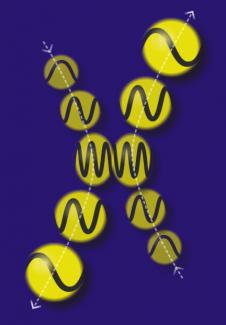"Watch" atoms collide! Thrill to the twists and turns of potassium atom wave functions as the atoms come closer and closer to impact! "See" the atoms deform, then recover as they smash together and fly apart inside a dense atomic vapor! It's all in a day's work for Graduate Student Virginia (Gina) Lorenz and Fellow Steve Cundiff.
The researchers use femtosecond pulses of laser light to probe atomic collisions. Their method is similar to using a stroboscope, which uses pulses of ordinary light to make tennis balls appear stationary as they fly through the air. In the case of the dense atomic vapor, the researchers send two pulses of laser light into the vapor. The first pulse synchronizes resonance oscillations of the atoms' emitted light (i.e., creates coherence). The second pulse gathers information about the dissipation of the coherence caused by atomic collisions.
The ultrafast laser pulses allow the researchers to "see" the atoms deform when they collide because the collision process changes the phase of the light the atoms emit. This is shown graphically by the changes in the sine waves on the tennis balls on the right. By varying the amount of time between the two laser pulses, the researchers can monitor what's happening as the atoms approach each other, collide, and fly apart.
The studies of how atomic collisions change emitted light provides insight into the relationship between classical, everyday tennis ball collisions and quantum level interactions.
The work reported here appeared in the October 13, 2005, issue of Physical Review Letters. - Julie Phillips




